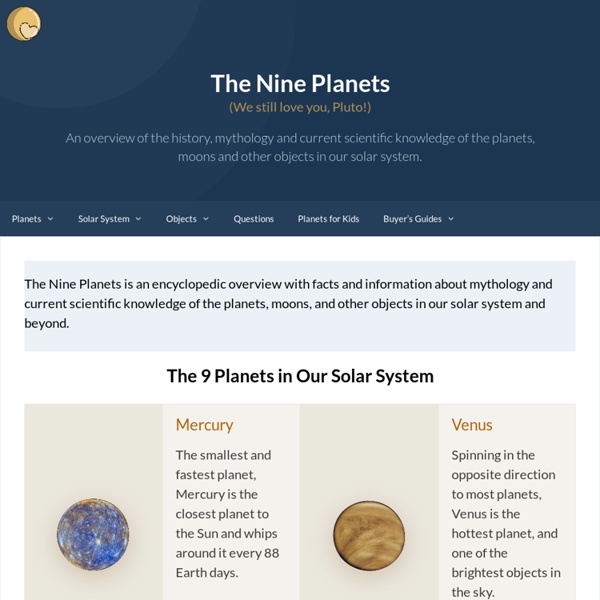



Planets – NASA There are more planets than stars in our galaxy. The current count orbiting our star: eight. The inner, rocky planets are Mercury, Venus, Earth and Mars. The outer planets are gas giants Jupiter and Saturn and ice giants Uranus and Neptune.
Earth's Sun: Facts About the Sun's Age, Size and History The sun lies at the heart of the solar system, where it is by far the largest object. It holds 99.8 percent of the solar system's mass and is roughly 109 times the diameter of the Earth — about one million Earths could fit inside the sun. [How Hot Is the Sun?] Lawrence Hall of Science - 24/7 Science How fast does the wind blow? What makes things sticky? Where do insects live and plants grow? What is the best way to clean up the environment? How do humans measure up in the animal kingdom? The Solar System: The Sun, Planets, Dwarf Planets, Moons, Asteroids, Comets, Meteors, Solar System Formation Our solar system is filled with a wide assortment of celestial bodies - the Sun itself, our eight planets, dwarf planets, and asteroids - and on Earth, life itself! The inner solar system is occasionally visited by comets that loop in from the outer reaches of the solar system on highly elliptical orbits. In the outer reaches of the solar system, we find the Kuiper Belt and the Oort cloud. Still farther out, we eventually reach the limits of the heliosphere, where the outer reaches of the solar system interact with interstellar space. Solar system formation began billions of years ago, when gases and dust began to come together to form the Sun, planets, and other bodies of the solar system.
NASA Kids Club Skip to main content NASA Kids Club › Text Only Site Window to Earth Timeline of Solar System exploration Charted timeline of Solar System exploration, as of December 2014 This is a timeline of Solar System exploration ordered by date of spacecraft launch. It includes: All spacecraft that have left Earth orbit for the purposes of Solar System exploration (or were launched with that intention but failed), including lunar probes.A small number of pioneering or notable Earth-orbiting craft.
Information, History, Size, Formation & Definition Our Sun is a normal main-sequence G2 star, one of more than 100 billion stars in our galaxy. The Sun Profile diameter: 1,390,000 km.mass: 1.989e30 kgtemperature: 5800 K (surface) 15,600,000 K (core) History of The Sun The Sun is by far the largest object in the solar system. It contains more than 99.8% of the total mass of the Solar System (Jupiter contains most of the rest).
Molecular Workbench Three Views of MW Senior Scientist and Molecular Workbench Developer Charles Xie, Researcher and Manager Amy Pallant, and Technology and Curriculum Developer Dan Damelin describe the history of Molecular Workbench and our vision for the future. Watch the Video undefinedundefinedundefined
The Solar System Our solar neighborhood is an exciting place. The Solar System is full of planets, moons, asteroids, comets, minor planets, and many other exciting objects. Learn about Io, the explosive moon that orbits the planet Jupiter, or explore the gigantic canyons and deserts on Mars. The Solar System and its planets The Solar System is made up of the Sun and all of the smaller objects that move around it. Apart from the Sun, the largest members of the Solar System are the eight major planets. Nearest the Sun are four fairly small, rocky planets - Mercury, Venus, Earth and Mars. Beyond Mars is the asteroid belt – a region populated by millions of rocky objects. These are left-overs from the formation of the planets, 4.5 billion years ago.